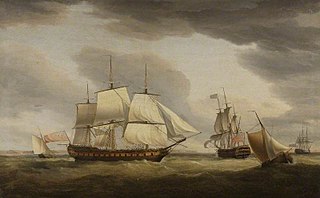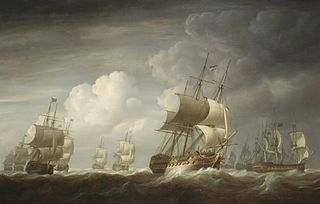Albion was an East Indiaman of the British East India Company (EIC). She made eight voyages for the EIC before she was sold to the British government in 1810 for service as a troopship. She was lost at sea in 1816.

Northumberland was launched in 1780 to serve as a regular ship of the British East India Company (EIC). She made six voyages for the EIC between 1780 and 1797. She was sold in 1797 for breaking up.
Airly Castle, was built by William Barnard at Deptford and launched in 1787. She made eight voyages as an East Indiaman for the British East India Company (EIC) between 1788 and 1808. In 1795 she participated in the capture of seven Dutch East Indiamen near St Helena. After her eight voyages she may have served briefly as a general transport before she was sold for breaking up in 1810. She was not broken up but instead served as a transport for several years.

Taunton Castle was launched on the River Thames in 1790 as an East Indiaman. She made nine voyages for the British East India Company (EIC) before she was broken up in 1813. In 1797, on her third trip, she was one of a fleet of six East Indiamen that bluffed a squadron of six French frigates into fleeing.

Rockingham was launched as an East Indiaman in 1785. She made seven voyages for the British East India Company (EIC) between 1786 and 1802 before she was sold for breaking up.
Woodcot was launched in 1786 as an East Indiaman for the British East India Company (EIC). She made four voyages for the EIC. The French captured her in 1798 at Tellicherry as she was homeward bound from her fifth voyage. American owners purchased her, renamed her Berkshire, and sailed her to Bombay in 1799.
Britannia was launched by the Bombay Dockyard in 1772, and was rebuilt in 1778. The British East India Company (EIC) apparently acquired her in 1775. Between 1779 she made eleven complete voyages as an East Indiaman for the EIC. She also participated in three naval campaigns, during the first of which she was deployed as a cruiser off Sumatra. There she engaged and captured a French ship. In the other two she served as a transport. She set out for her twelfth EIC voyage but was lost in 1805 during the third naval campaign.
Lord Camden was launched in 1783 as an East Indiaman for the British East India Company. She made five voyages for the EIC before her owner sold her.

Lord Hawkesbury was launched in 1787 as an East Indiaman for the British East India Company (EIC). She made eight voyages for the EIC before she was sold in 1808 for breaking up.
Contractor was launched in 1779 as an East Indiaman. She made seven voyages for the British East India Company (EIC). She made one voyage as a transport for a military expedition before her owners sold her in 1800 for use as a transport.
Duke of Montrose was launched in 1785 as an East Indiaman. She made eight voyages for the British East India Company (EIC). She then briefly became a troop transport, sailing to the West Indies. She was sold in 1811 for breaking up.
Earl of Wycombe was launched in 1786 as an East Indiaman. She made six voyages for the British East India Company (EIC). In 1800 she became a general trader, trading across the Atlantic to the West Indies and Canada. She was lost without a trace c.1803.

Essex was launched in 1780 as an East Indiaman. She made six voyages for the British East India Company (EIC). On her first voyage she was present at an inconclusive battle with the French, and later at a second inconclusive engagement with a French frigate. In 1798 she was sold to be hulked or broken up.

True Briton was launched in 1790 as an East Indiaman for the British East India Company (EIC). She was lost without a trace in 1809 during her eighth voyage.
General Eliott was launched in 1782 as the East Indiaman Fletcher, but was renamed before completion to honour General Elliott's defence of Gibraltar. Under the ownership of Robert Preston, she made six voyages for the British East India Company (EIC) and one voyage as a transport for a naval expedition. She then became a West Indiaman until she was sold for breaking up in 1802.
Deptford was launched in 1781 as an East Indiaman. She made six apparently uneventful voyages for the British East India Company (EIC) before she was sold in 1807 for breaking up.
Worcester was launched in 1785 as an East Indiaman for the British East India Company (EIC). She made eight voyages to India and China for the EIC and participated as a transport in two naval expeditions before she was sold in 1809 for breaking up.

Belvedere was launched in 1787 at Itchenor. She made six voyages for the British East India Company (EIC). She then briefly sailed as a West Indiaman. She was broken up by 1805.
Walpole was launched on the Thames in 1779. She made seven voyages for the British East India Company (EIC). On the sixth voyage, on her way to China, her captain discovered an island that he named Walpole Island. She was sold for breaking up in 1799.
London was launched in 1779 as an East Indiaman. She made seven voyages for the British East India Company (EIC), between 1780 and 1798. She was sold for breaking up in 1799.






